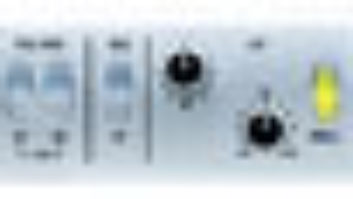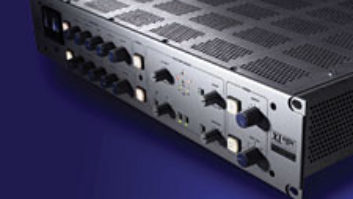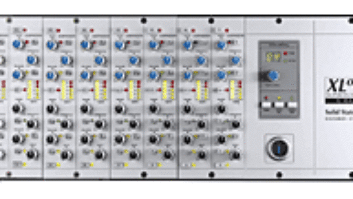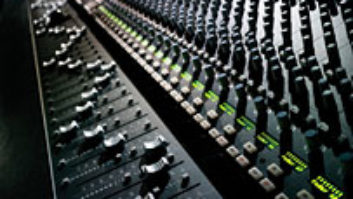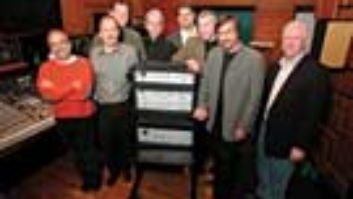
Solid State Logic consoles populate many of the top studios in the world. Now, the company offers every studio that SSL sound for a fraction of the cost of one of its consoles. Taking the electronics from one channel of its SuperAnalogue XL 9000 console, SSL has added a couple of extra features and put it into a 1U rackmount unit.
WHAT IS SUPERANALOGUE?
SSL calls its gear SuperAnalogue because this unit’s noise and frequency specs exceed the limits of current PCM digital recording, even when operating at 192 kHz/24-bit. Looking under the hood, I found surface-mount technology and high-quality components. The preamp/input stage is transformerless and very low-noise. Multiple DC servo circuits replace the need for capacitor coupling between each stage in the strip and are largely responsible for the low-frequency response down to 3 Hz. DC servos also minimize the phase distortion inherent in capacitor-coupled designs. The upper bandwidth of 200 kHz is achieved by component choice, circuit board layout and design. High headroom, low distortion, extra attention to transient signal response and custom oxygen-free cables are also touted as reasons for the SuperAnalogue nomenclature.
SEND IN THE CLONES
The XLogic Channel is a clone of the XL console channel strip with a few extras. The XLogic Channel has two inputs that feed the input stage: one in the rear of the unit and the other on the front. The front input uses a ¼-inch XLR jack with a switch that selects the mono instrument input while raising the input impedance to 1 Mohm, which won’t load down guitar pickups.
The output section allows for ±20 dB of gain. It includes a seven-segment LED meter that can be switched to show the channel’s output or the signal level after the input section. Another LED indicates when the optional A/D card is locked to an external clock.
The original 9000 console has dual-purpose knob/switches in the dynamics section to control RMS/peak sensing, fast or normal attack, and gating or expanding. The XLogic Channel uses separate dedicated buttons and level controllers for these parameters. The Filters knobs have also been changed from the variable fader with a click-off position to a sweepable fader and a separate on/off button. I prefer the new format, especially with the filters, because it’s easier to switch them out while keeping your previous settings. On the console, you may have to pull the knobs to see how they are set. The switches on the XLogic channel have LEDs that make it easy to see which modes you are in.
The 4-band equalizer is switchable between the SSL’s G and E Series EQ curves. The differences deal with the Qs of the low-mid and high-mid bands and whether or not the LF and HF bands have some overshoot/undershoot. These are the classic SSL EQs. If you’ve worked on an SSL, you already know how they operate and sound.
The number of routing options is unparalleled. Depending on how you engage the switches, you can completely control the order of signal processing: You want the filter first, then the EQ and then the dynamics? No problem. The XLogic Channel also allows the EQ and filters to be placed in the dynamics sidechain for frequency-dependent compression and/or gating/expanding. All of these processing chains are easily engaged with a press of a button or two. Key input allows external control of the dynamics sidechain, and a Link button can be used with multiple units for stereo operation.
HOW TO GET THAT XL SOUND
I used this unit to record guitars, vocals, horns, bass, kick and snare drums, with and without processing. The mic preamp was particularly nice on vocals. With up to 72 dB of input gain, it also worked well with low-output ribbon mics. This excellent-sounding piece of equipment never disappointed me.
I noticed the transparency of the filters and dynamics when they were switched into the circuit. There’s almost something magical about the way the SSL compressor works; nothing was lost in translation from console channel strip to the rackmounted version.
The input stage does not have a traditional line input setting. On the XLogic console, the line input uses a ±20dB amplifier. Like the console, the XL Channel has a hi-Z switch that brings the input impedance of the XLR inputs from 1.2k ohms to 8.45k ohms, but the minimum amount of gain that can be applied at this stage is 6 dB. Translation: If you feed a line-level signal into the input stage without engaging the pad, then you will be adding 6 dB of gain. To set the input to unity, you have to select the pad (fixed at -18 dB) and then set the input gain to +18 dB. This seems like a convoluted way to achieve input unity gain at the cost of increased noise, but SSL claims that even under these circumstances, the unit has an equivalent input noise of less than -90 dBu. SSL affirms that by selecting the combination of the hi-Z input low-gain settings on the mic pre, the circuit will perform as well as the normal console line input. The channel strip set to unity will accept up to +27 dB without any more noise or distortion than you would get from a normal line input. When I tested this unity gain setup, I could not hear any increase in noise.
I’LL TAKE TWO
Some people might find the XLogic Channel’s price of $3,600 a bit high, but when you consider that this includes a mic/instrument preamp, high- and lowpass filters, a compressor, gate and an equalizer (with two different characteristics), you realize you’re getting a lot in one box. Everywhere I took this unit, people were eager to find out if the XLogic would deliver the SSL sound — and it lived up to its name.
Solid State Logic, 44/1865 842300, www.solid-state-logic.com.
Erik Zobler has worked on more than 200 album projects, but is most proud of mixing the Sony/Revolution film Gigli. You can reach him at
[email protected].
